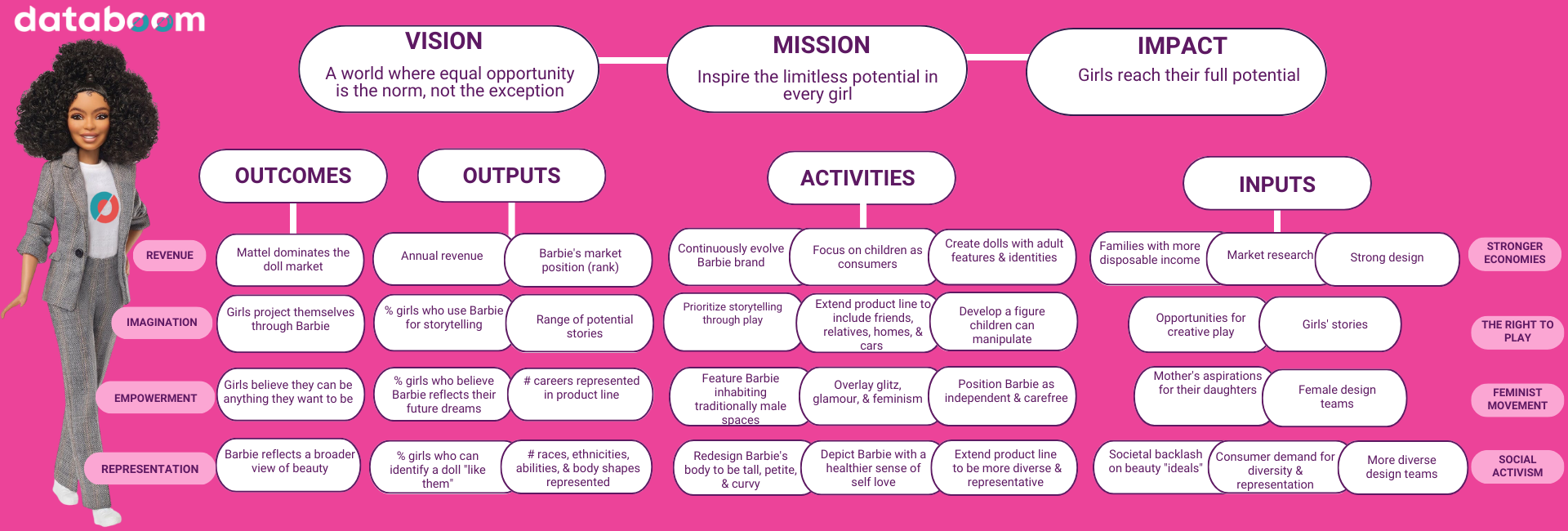Barbie is a cultural icon. Whether you love her or hate her, no one can deny her sphere of influence. Over the last month, how many times has someone asked, “Have you seen the Barbie movie yet?”
Putting yourself in Barbie’s shoes, be it flats or heels, means that you can talk about anything – fashion, politics, race, body image, or economics – but can you say that Barbie’s made the world a better place?
Among other things, Greta Gerwig’s movie has reignited discussions about feminism, gender norms, body image, representation, and consumerism. Dare we say, Barbie comes with a lot of baggage? The Databoom team tried to unpack some of Barbie’s little pink suitcases and apply a measurement lens: her sphere of influence and Mattel’s ability to respond to the changing world around her.
Since Barbie’s debut in 1959, she has been a target of both delight and criticism. Initially designed to show girls they could be anything, Barbie has faced backlash over projecting an unrealistic body image, reinforcing traditional gender norms, and lacking representation. During her 64 years, Barbie has also encountered several economic, political, social, and cultural movements.
So, Databoom did something we do best – we developed a logic model. We also created a persona for Evaluator Barbie. We call her “EB” for short. EB, of course, works at Databoom, is great with clients, and is equally smart and stylish. Her accessories include sensible shoes, tons of caffeine, a Zoom account, multiple computer screens, a high-speed internet connection, a pink highlighter, and a library card from graduate school that never expires.
We identified how EB could evaluate how well Mattel responded to big movements (and sales volatility) and listed appropriate measures to monitor and evaluate performance.
We looked at four movements that have intersected with the Barbieverse over time:
1) A shift to stronger economies
2) Children’s right to play
3) Feminism
4) Social activism
We then identified the inputs, activities, and outputs associated with some key outcomes that Mattel set out to achieve through Barbie.
As a profit-driven company, Mattel is most motivated to measure #1 – how Barbie affects its bottom line, its revenue, and market position. But what if EB took a harder look at Barbie’s contribution to more meaningful change, like a world of imagination, empowerment, and representation?
Based on EB’s fabulously pink logic model, here are the research questions she is setting out to tackle:
1) Do routine visits to Barbie Land mean that children spend more time storytelling and imagining their world through Barbie?
2) If Barbie is shown inhabiting traditionally male spaces and living an independent and carefree lifestyle, do girls believe that they can be anything they want to be?
3) Now that Barbie comes in a variety of races, ethnicities, identities, abilities, shapes, and sizes, does Barbie reflect a broader view of beauty?
There are likely hundreds of other relevant research questions that would keep EB and her friend, Dissertation Barbie, gainfully employed for the next 64 years. There are also several other fabulously pink logic models that she could develop. At least this is a start and a challenge to private sector giants like Mattel to do more than say that they’re creating a better world. They should measure it.
Photo Credit: Mattel, Inc.




